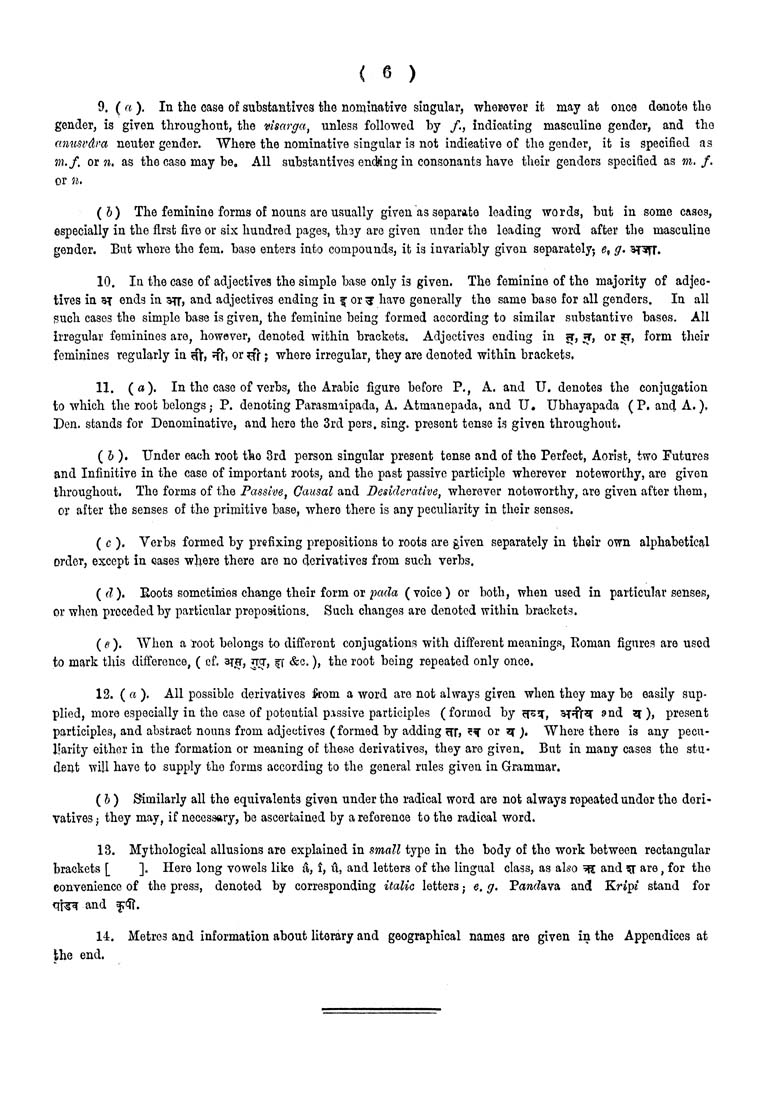< 6 )
9. ( a ). In the case of substantives the nominative singular, wherever it may at once d^uote the
gender, is given throughout, the marga^ unless followed by /., indicating masculine gender, and the
cmtisvdra neuter gender. Where the nominative singular is not indicative of the gender, it is specified as
m.f. ox n, as the case may be. All substantives endftng in consonants have their genders specified as m. f.
or 71,
(h) The feminine forms of nouns are usually given as separate leading words, but in some cases,
especially in the first five or six hundred pages, thoy are given under the leading word after the masculine
gender. But where the fem. base enters into compounds, it is invariably given separately*, e^ g> b?^.
10. In the case of adjectives the simple base only is given. The feminine of the majority of adjec¬
tives in BT ends in ^Tf, and adjectives ending in f or ;f have generally the same base for all genders. In all
Buch cases the simple base is given, the feminine being formed according to similar substantive bases. All
irregular feminines are, however, denoted within brackets. Adjectives ending in h, ^, or ^, form their
feminines regularly in rflij ^j o^ ^f; where irregular, they are denoted within brackets.
H. (a). In the case of verbs, the Arabic figure before P., A. and U. denotes the conjugation
to which the root belongs,- P. denoting Parasmaipada, A. Atmanepada, and U# Ubhayapada (P. and A.),
Den. stands for Denominative, and here the 3rd pers. sing, present tense is given throughout.
( 6 ). Under each root the 3rd person singular present tense and of the Perfect, Aorist, two Futures
and Infinitive in the case of important roots, and the past passive participle wherever noteworthy, are given
throughout. The forms of the Passive, Causal and Besiderative, wherever noteworthy, are given after them,
or after the senses of the primitive base, where there is any peculiarity in their senses.
( c ). Verbs formed by prefixing prepositions to roots are given separately in their own alphabetical
order, except in cases where there are no derivatives from such verbs.
( d)» Roots sometimes change their form or pada (voice) or both, when used in particular senses,
or when preceded by particular prepositions. Such changes are denoted within brackets.
(e). When a root belongs to different conjugations with different meanings, Roman figures are used
to mark this difference, ( cf. arjr, jq*, ff &c.), the root being repeated only once.
13. (a). All possible derivatives &om a word are not always given when they may be easily sup<
plied, more especially in the case of potential passive participles ( formed by ^z^^ BT^t^ ^nd ^ ), present
participles, and abstract nouns from adjectives (formed by adding ^r> ?^ or ^ ). Where there is any pecu¬
liarity either in the formation or meaning of these derivatives, they are given* But in many cases the stu¬
dent will have to supply the forms according to the general rules given in Grammar.
( 6 ) Similarly all the equivalents given under the radical word are not always repeated under the deri¬
vatives j they may, if necessary, be ascertained by a reference to the radical word.
13. Mythological allusions are explained in small type in the body of the work between rectangular
brackets [ ]. Here long vowels like a, t, u, and letters of the lingual class, as abo ^ and ^ are, for the
convenience of the press, denoted by corresponding italic letters; e, g. Paw^^ava and Kr^pe stand for
qf^ and fit,
14. Metres and information about literary and geographical names are given in the Appendices at
the end.
|








